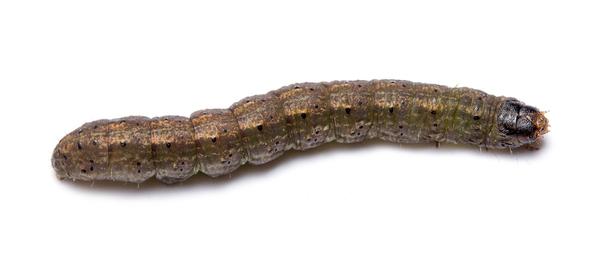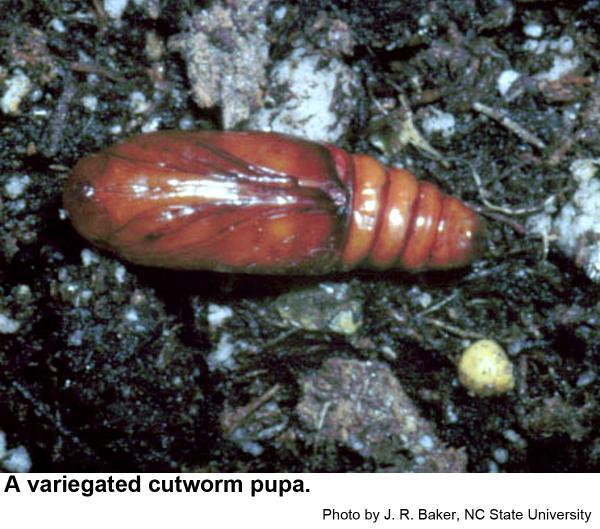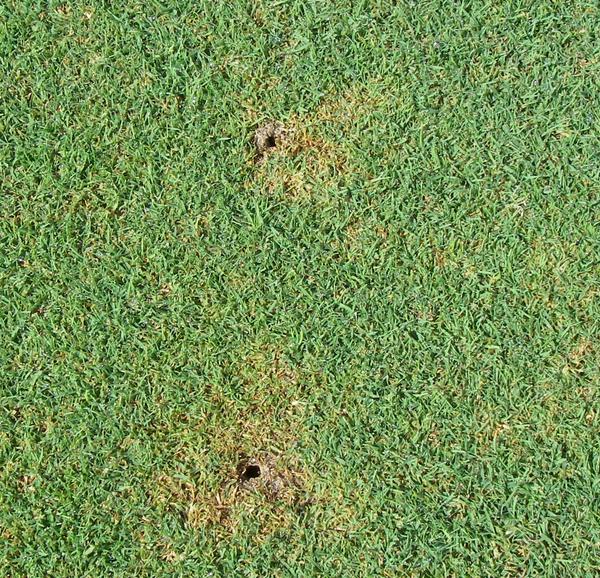Introduction
Cutworms are caterpillars that feed on the stems and leaves of young plants and often cut them off near the soil line, hence their common name. Although there are many important species of cutworms, the black (Agrotis ipsilon Hufnagel), bronzed (Nephelodes minians Guenée), granulate Feltia subterranea (Fabricius), and variegated cutworms (Periodroma saucia Hübner) are the ones most commonly encountered on North Carolina turfgrass.
Description
Larvae of each species look very similar and are very difficult to distinguish from each other. Black cutworms range from dark green to gray to black, typically with a pale stripe down the back. Bronzed cutworms are dark brown to black on the dorsal side and have three narrow yellow stripes and a broad white-yellow stripe running down each side. Granulate cutworms are dark brown to gray with yellow-gray lateral stripes running down each side. Variegated cutworms are gray to brown and have an orange lateral stripe (Figure 1). Adults are generally gray-brown with wing spans of approximately 1.4-1.8 in. (Figure 2, Figure 3). Black cutworm adults have a pair of black triangular markings.
Pest Status
Black cutworms are pests of bentgrass, Poa annua, and occasionally perennial ryegrass. Black cutworms are typically a problem on short-mown turf (golf course greens, tees and fairways) and are rarely an issue in home lawns. Other species of cutworm can be occasional pests of home lawns of all kinds of turfgrass species.
Biology
In the southeast, cutworms can have as many as six generations a year. Female moths lay their eggs singly on the tip of a leaf blade. Eggs hatch within 3-10 days and larvae will either create tunnel holes into the thatch or use aeration holes to easily reach the soil. Larvae will complete development within 20-45 days and become pupae (Figure 4) for approximately two weeks before emerging as adults.
Damage
Cutworms can damage turf when burrowing through the thatch or into the ground. At night they emerge and chew stems and blades near the soil. The damage may appear as circular spots of dead grass, finger-sized brown crescents or ball marks on a golf green (Figure 5). Many cutworms prefer wilted plant material and sever the plants sometime prior to feeding. Cutworms are typically active in spring and fall and may strip large areas of turf at ground level. Damage may be worsened when aerification of the turf occurs.
Control
Cultural Control
Kentucky bluegrass is a non-preferred host, for black cutworm, compared to creeping bentgrass and perennial rye and may reduce infestation. This may be used in mixed turf or in border areas. Collection and removal of clippings from a recently-mowed area may be helpful in removing eggs from the turf stand.
Biological Control
When monitoring for cutworms (see Monitoring for Turfgrass Insects), a general threshold of 2-6 larvae per square yard may indicate a need for an insecticide application, although this threshold could change depending on site. Precede chemical treatments with mowing 24 hours prior to treatment. Apply chemicals in the evening for optimal night time contact. Use liquid formulations, apply as late in the day as possible, and avoid irrigating for at least 24 hours. Treating a 20-30 foot buffer zone around greens and tees will reduce migration from outlying areas.
Specific recommendations for home lawn and commercial control can be found in the North Carolina Agricultural Chemicals Manual.
Chemical Control
When monitoring for cutworms (see Monitoring for Turfgrass Insects), a general threshold of 2-6 larvae per square yard may indicate a need for an insecticide application, although this threshold could change depending on site. Precede chemical treatments with mowing 24 hours prior to treatment. Apply chemicals in the evening for optimal night time contact. Use liquid formulations, apply as late in the day as possible, and avoid irrigating for at least 24 hours. Treating a 20-30 foot buffer zone around greens and tees will reduce migration from outlying areas.
Specific recommendations for home lawn and commercial control can be found in the North Carolina Agricultural Chemicals Manual.
| Insecticide and Formulation | Amount per 1,000 sq ft | Precaution and Remarks |
|---|---|---|
| acephate* (Orthene T, T&O) | 1.2 to 2.4 oz | Commercial and residential turf only. |
| azadirachtin* (Neemix, Turplex) | See label | |
| bifenthrin* (Menace, Talstar, others) F, GC; G form also available | 0.18 to 0.25 fl oz | Use GC formulation for golf courses. |
| Bt products, various labels | See label | |
| carbaryl* (Sevin) 80 WSP and baits | 0.75 to 1.5 oz | Treat in late afternoon. Apply in adequate water for good coverage but do not flood or water in. Do not cut grass for 1 to 3 days after treatment. |
| chlorantraniliprole (Acelepryn) | 0.046 to 0.092 fl oz | |
| chlorpyrifos* (Dursban) 4 E, 2 ES, 50 WP, Pro | See label | For use on golf courses; check new label. |
| chlothianidin (Arena) .5G | 1.4 to 1.8 lb | Cutworms only. |
| chlothianidin (Arena) 50 WDG | 0.2 to 0.3 oz | Cutworms only. |
| chlothianidin + bifenthrin (Aloft) | See label | |
| chlothianidin + bifenthrin (Aloft) GC SC | 0.27 to 0.54 fl oz | |
| chlothianidin + bifenthrin (Aloft) LC SC | 0.27 to 0.54 fl oz | |
| chlothianidin + bifenthrin (Aloft) GC G | 1.8 to 3.6 lb | |
| chlothianidin + bifenthrin (Aloft) LC G | 1.8 to 3.6 lb | |
| cyfluthrin* (Tempo 2) | 0.143 fl oz | Home lawns only. |
| deltamethrin (Deltagard) G | 2 to 3 lb/1,000 ft | |
| entomogenous nematodes* | See label | Read and follow special application instructions. Effective only against small cutworms. |
| indoxacarb (Provaunt) SC | 0.0625 to 0.25 fl oz | Not labeled for use on sod farms. |
| lambda-cyhalothrin* (Battle, Scimitar, Cyonara) | See label | Do not make applications within 20 feet of any body of water. No reentry until spray has dried. |
| spinosad A or D (Conserve) SC | 1.25 fl oz | Rate varies with size and species. |
| trichlorfon (Dylox, Proxol) 80 SP | 1.5 to 3 oz | |
| Dinotefuran (Zylam) 20SG | 1 oz |
References
- Cutworm. Toennisson, A. 2015 (update). Entomology - Insect Biology and Management, NC State Extension.
- Cutworms. Hahn, J., S. Wold-Burkness, and B. Birlin. 2018 (reviewed). University of Minnesota Extension Yard and garden insects.
- 2018 Pest Control for Professional Turfgrass Managers. Bowman, D. et al. 2017. NC State Extension Publication AG-408.
- NC State Plant Pathology Publications and Factsheets
- NC State Horticultural Science Department Publications
- North Carolina Agricultural Chemicals Manual
For assistance with a specific problem, contact your local N.C. Cooperative Extension center.
Publication date: Oct. 25, 2017
Recommendations for the use of agricultural chemicals are included in this publication as a convenience to the reader. The use of brand names and any mention or listing of commercial products or services in this publication does not imply endorsement by NC State University or N.C. A&T State University nor discrimination against similar products or services not mentioned. Individuals who use agricultural chemicals are responsible for ensuring that the intended use complies with current regulations and conforms to the product label. Be sure to obtain current information about usage regulations and examine a current product label before applying any chemical. For assistance, contact your local N.C. Cooperative Extension county center.
N.C. Cooperative Extension prohibits discrimination and harassment regardless of age, color, disability, family and marital status, gender identity, national origin, political beliefs, race, religion, sex (including pregnancy), sexual orientation and veteran status.





